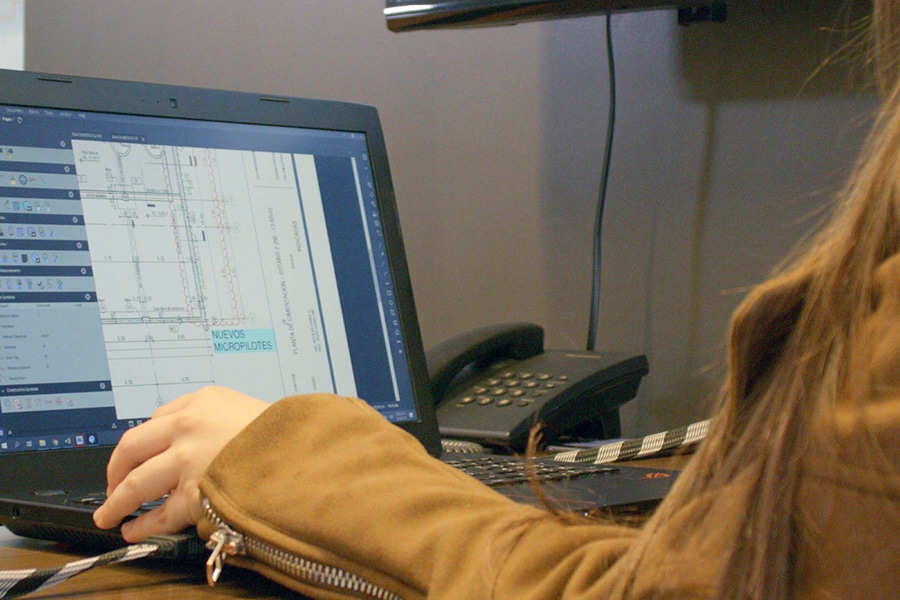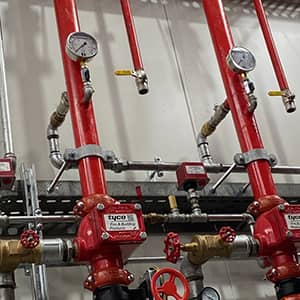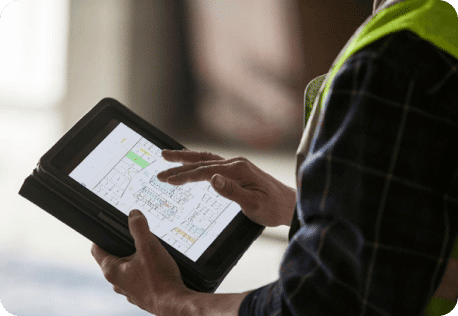
When growth requires change
ARPRO is an architectural design, construction and project management company in Bogota, Colombia, that will soon complete Atrio, its most ambitious project in 41 years. Atrio is comprised of two towers: the North Tower will feature mixed-use commercial development, and the South Tower will be the tallest structure in Colombia – at 67 floors and 268 metres.
As the scale of ARPRO’s buildings expanded, so did the challenges of internally managing documents and information, as well as managing clear communication with stakeholders and partners. When ARPRO was finishing the initial drawings for Atrio, it requested that Ellisdon, a Canadian steel manufacturer, supply the building materials.
Ellisdon then introduced ARPRO to Bluebeam Revu as a way to mark up and collaborate on PDF project plans. Once the designers at ARPRO began using Revu, they immediately saw the advantages for design and collaboration. The designers also found in it the solution to handling the rapidly growing volume of documents necessary for large projects such as Atrio. Revu was exactly the solution that ARPRO was seeking, but ARPRO still had the test of implementing a wholly new approach to the daily work of its team.
‘The challenge was more about culture change in the area of construction – that is, for people to begin managing physical plans and migrating to a digital platform’, said Margaret Tachack, director of planning at ARPRO.
Rodrigo Rubio Vollert, development manager at ARPRO, described the process: ‘You have to go step by step, understand how this tool will transform the organisation, and you can only do that by carefully managing the transformation and respecting the way that valuable people in the organisation are integrating with the new tool.’
ARPRO’s main office has 60 employees, with another 240 in the field on any given day, building or managing projects on site. Any significant change in operations requires that every team member buy in and participate, letting go of old processes to make room for new ones. The executives at ARPRO knew that this is particularly true of team leaders and high performers, who set the example for the entire company. Leaders could hasten or delay the implementation of Revu, depending on how quickly they could be sold on the advantages of a digital platform.

‘Over time, [team leaders] will select prototype projects where they can have early victories in order to incorporate these tools properly’, Vollert said.
Changing to a digital platform benefits everyone, but it also requires every team member to buy in. Although designers might initially baulk at using a digital platform for design, they buy in once they see the ease and efficiency of using Revu. Virtual meetings replace travelling for face-to-face meetings, and there’s real-time access to plans using Bluebeam Studio in the field for technicians and subcontractors. Moreover, designers love that Revu creates a single source of truth that is always up to date and easy to find, as well as that it allows team members to mark up designs intuitively, which is a change from organising and keeping track of thousands of physical plans. Atrio, for example, had 15,000 plans, some of which had 75 versions, which needed to be worked on simultaneously. Simultaneous efforts such as these are possible in Revu through the Overlay Pages and Batch Slip Sheet features. While using these features will save team members’ time, it requires an initial training and adaptation.
‘I remember a very important moment, when I found one of our project supervisors with some officials and assistants from the construction team interacting around the Bluebeam [Revu] platform and our digital dashboard in order to get to know the project and discuss it so they could do their work better. That seemed to me maybe the most exciting moment because it wasn’t about a tool that requires specialised training or special conditions to be able to use it; it was really that, well, everyone involved was enjoying the benefits of this tool.’
Rodrigo Rubio Vollert
Development Manager
ARPRO
Tachack said that the company ‘had to give training on all the projects at ARPRO, and we created some specific modules since Bluebeam [Revu] enabled us to open different formats.’ Since ARPRO started using Revu, its team has reoriented its entire day-to-day operations, improved communication and direction and now saves US$30,000 (AU$43,000) each year by reducing paper waste.
Furthermore, Revu has helped ARPRO standardise mundane tasks, which has led to significant, though intangible, gains by eliminating duplicate work and minimising risks and errors. As Vollert describes, ARPRO has saved time and money by ‘avoiding reprocessing, from identifying errors on time, from generating deeper project knowledge among all participants, which makes it possible for us to complete our construction programs and meet construction budgets on the different projects we’ve carried out.’
Vollert recalls: ‘I remember a very important moment, when I found one of our project supervisors with some officials and assistants from the construction team interacting around the Bluebeam [Revu] platform and our digital dashboard in order to get to know the project and discuss it so they could do their work better. That seemed to me maybe the most exciting moment because it wasn’t about a tool that requires specialised training or special conditions to be able to use it; it was really that, well, everyone involved was enjoying the benefits of this tool.’
The ARPRO digital dashboard
At the centre of ARPRO’s transition from paper to digital was their custom digital dashboard, which is the central hub for document management, calendars and schedules, project updates and statuses, and design review for every employee and stakeholder. Daniel Rodriguez, BIM director at ARPRO, said that its digital dashboard is ‘public information, visible to anyone from our team, the contractor team, inspectors and the client. It’s synchronised in real time online and has allowed us to get the information to the teams much faster than before and with greater certainty that it’s correct.’
ARPRO’s digital dashboard handles virtually every document and tracks every project through its lifecycle. The team has standardised internal and external processes and made its dashboard both easy to navigate and the project tracking and reporting simple to understand. That means when a subcontractor or a stakeholder that doesn’t use Revu on a regular basis visits the dashboard, they can quickly and painlessly find the information they need without guidance from an ARPRO employee.
As Vollert describes, adapting to Revu was more than ‘just a basic adaptation; we’ve been able to incorporate personalised forms that reflect the exact needs of our company in managing documents.’

‘The function of Bluebeam [Revu] that we use most within the digital dashboard is related to the current plans and specifications menu. We automatically connect the plans with hyperlinks, and Batch Link is one of the tools we use most for that. When we receive the plans, we process them automatically so they are connected with others, and we also make revisions with Overlay Pages that allow us to identify the changes very quickly for the whole team.’
Daniel Rodriguez
BIM Director
ARPRO
The digital dashboard has eight modules hosted in Bluebeam Studio. These modules cover current plans and specs; workshop plans; information requests; visual project progress by level and speciality; a photo menu to show progress; and 3D PDFs that track construction progress. The last two menus are project logistics and legal documents. Every document that’s necessary to plan and build, from blueprints to contracts and licences, is within the digital dashboard.
Every plan developed or received at ARPRO now goes through the same process within the digital dashboard. The plans are reviewed and validated in technical coordination and simultaneously compared to other versions of plans through Overlay Pages, so all changes are clear and traceable. The plans are then put through Batch Link, which automatically creates navigational hyperlinks so all project plans are easy to find.
As Rodriguez describes: ‘The function of Bluebeam [Revu] that we use most within the digital dashboard is related to the current plans and specifications menu. We automatically connect the plans with hyperlinks, and Batch Link is one of the tools we use most for that. When we receive the plans, we process them automatically so they are connected with others, and we also make revisions with Overlay Pages that allow us to identify the changes very quickly for the whole team.’
Once a package of plans is reviewed and approved, it becomes the ‘plans of construction’ and moved to a different module of the dashboard, where it’s available to the appropriate parties. The plans are then shared with the field when they’re needed, and construction takes place in line with correct quality standards and building regulations. Throughout the lifecycle of these documents, the digital dashboard is the only means of real-time consultation for users and stakeholders in management, design and building. Nobody has to wait to see the latest and truest version of a design, including markups or comments. This real-time tracking of design changes creates a waterfall of time savings for every stakeholder in a project.
A new brand advantage
The ARPRO digital dashboard has evolved over time to where designers, managers, operators and builders are all consulting and using the features and workflows within Revu. But the dashboard has also grown into an important selling point for ARPRO in the local trade, and it has become part of the ARPRO brand.
‘We’re converting it into a standardised product we use on all new projects. We’ve been able to show that workflow within Bluebeam [Revu] as an organisation method for construction teams under the digital dashboard [ARPRO] brand’, Rodriguez said. Furthermore, ARPRO took full advantage of the transition to digital as an opportunity to develop its internal workflows and defined protocols under the Building Standard parameters.

Now, ARPRO has a dozen projects in the pipeline that it’s designing and reviewing within Revu, and all of the company’s documents are managed through the digital dashboard. Bluebeam Revu and Studio offer numerous advantages and savings for any business in the design and building world, but it’s always up to the users to implement the tools as they see fit. In the case of ARPRO – and the soon-to-be-completed jewel of its portfolio, Atrio – adopting Revu completely changed its operations and ‘made us the benchmark for the local industry’, Rodriguez said.
For any design or building professional that’s considering a change to a digital platform, Vollert has a bit of advice. ‘My recommendation is definitely to start down this road as early as possible and use it as a launching point for digital model management, which is so important in our industry.’ In the case of ARPRO, embracing change has not only saved money, but broadened the horizon and prepared its business for another 40 years of success.
Arpro is located in Colombia and purchased Bluebeam products through Central de Soluciones, a Bluebeam Emerging Reseller.




